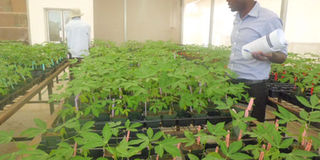Biotechnology in Africa: Some are cautious, others take the plunge

Scientists examine GM cassava plantlets in a screen house. While Uganda has made strides in research side, it is stagnant on legislation on biotechnology. PHOTO BY LOMINDA AFEDRARU
Scientists breeding crops using biotechnology are bound to safe use. This therefore calls for each country to make sure that there is a legal framework in place.
It is strengthened by the commitment of state parties through Convention on Biological Diversity and the Cartagena Protocol on Biosafety.
The convention emphasises the need to protect human health and environment from the possible adverse effects.
At a recent conference in Kampala, Akile Sunday Igu, the programme officer, African Biosafety Network of Expertise (ABNE), presented a paper on the Regulatory Status of Biotechnology Applications in the East Africa Community.
Biosafety legislations operate within a framework of other legislations of a particular country. These may include environment, administrative and civil legislations where liability and redress in civil matter could have been laid.
For instance, most countries in East Africa have an administrative system which is governed by a National Biosafety Committee (NBC).
It is mandated to handle application for permits for research, multi-location trials and commercial releases.
The regulatory status of biotechnology in the five East African countries indicates that the countries consented to the Cartagena Protocol between 2003 and 2008.
Burundi and Rwanda acceded in 2008 but have no functional regulatory system and very limited human resource.
Tanzania consented to the same in 2003 and their biosafety regulation is provided under the Environmental Management Act.
Akile states that Uganda has reached a milestone in Sub Saharan Africa in terms of research with more than 15 products at confined field trials.
Steady progress
Supervision of research is done by research institutes and monitored by Uganda National Council for Science and Technology (UNCST).
There is a policy in place—the Biotechnology and Biosafety Policy 2008—and an administrative system capable of receiving applications, reviewing, and making decisions.
There are Institutional Biosafety Committee (IBCs) in place.
There is capacity to inspect, monitor and review decisions facilitated by the collaboration with other agencies such as Ministry of Agriculture, Environment and Health.
Despite the good system in place there is stagnation because Uganda does not have the legislation on biotechnology.
Kenya ratified the Cartagena Protocol on the same day as Uganda and its National Biosafety Authority was established by the Biosafety Act of 2009.
There is a National Policy on Biotechnology and Biosafety under which its administration is set up. The agency conducts its business through a Board of Directors.
Akile contends that there is a challenge presented by the varying regulatory status in East Africa in as far as biotechnology is concerned because many of diseases, pests and viruses ravaging agriculture is because of common factors in the region.
The languages, relations across borders, porous international boundaries with understaffed customs and phytosanitary officers is yet another challenge because there is no way farmers will be stopped from exchanging farm items including seed.
Similar ecological settings facilitate exchange of some of the products for propagation thus the same issues could lead to spread of GM materials as there is no regulation in place.
Already there is collaboration in research amongst sister agencies in the region meaning products to be released will have similar benefits.
Some successes
Given biotechnology application in Africa, Akile cited Burkino Faso, Nigeria, South Africa, Ghana, Namibia and Kenya as countries which have the laws in place.
Sudan, which is growing Bt cotton, implemented it through its National Variety Release Committee. It approved the release of two Bt cotton varieties, a hybrid and an open pollinated one for commercial production.
In 2013, the farmers planted Bt cotton on 121,500 hectares in rain-fed areas and on 81,000 hectares under irrigation. The yields led to 126-166 per cent increase of cotton production.
Other countries carrying out trials in Bt cotton include Malawi and Ghana.
The Nigeria government prioritised the functionality of its biosafety regulatory system before passing the biosafety law in 2015.
Before then, biosafety was administered within the existing legal framework to ensure the commencement of multi-location trials in the country for Maruca-resistant cowpea and confined field trials for bio fortified sorghum.
Other countries coming on board include the following. Zambia that has reviewed her strict legislation to pave way to receiving biotechnology applications. Zimbabwe has put in place an authority. Ethiopia has amended its biosafety proclamations by removing harsh penalties for errors and omissions to pave way for confined field trials. Mozambique amended her biosafety law by the end of 2014 and are in the process of establishing a biosafety regulatory system and Cameroon is conducting confined field trials.




